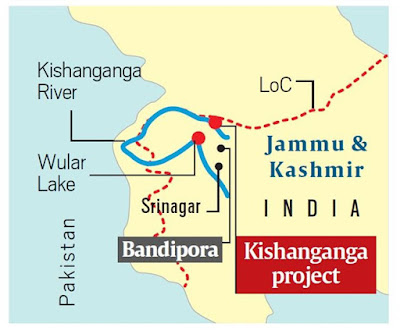In November 2016, as
India-Pakistan tensions escalated in the weeks after the attack in Uri and
India’s much publicised strike-back, workers at the Kishanganga Hydel
Electricity Project in Gurez in North Kashmir
experienced for the the first time the dangers of the Line of Control. In all,
18 shells fell from across the LoC, just a kilometre
away over the hills, on both sides of the dam, which was then close to
completion.
“All of us just left whatever we
were doing and ran into the tunnel,” said Sanjay Kumar, an employee of the
construction company building the dam.
The tunnel, completed in June
2014, is an integral part of the KHEP — it takes the water from the Kishanganga
River in Gurez Valley to an underground power station
at Bandipora in the Kashmir Valley. Back then, there was no water in it.
According to dam officials, along with the workers, a large number of villagers
too, rushed into the tunnel for shelter, and demanded to be evacuated.
“We had to call the Army for
help,” a dam official said.
“But that was the first and last
time this happened in all my years here,” said Kumar, who joined the project in
November 2009.
On Monday, following intelligence
reports of cross-LoC infiltration bids in Gurez, the government decided to review security at KHEP. Hundreds of CISF personnel currently guard the dam. An Army camp deployed on the LoC is nearby, providing an
added layer of overall defence for the dam. During a recent visit by this
correspondent, a row of artillery guns inside
the camp was visible from the road, their barrels
trained at the mountain.
If India decided to locate the
project there despite the evident dangers of the LoC, it could not have been
without the confidence that it could handle this challenge, dam officials who
did not wish to be named, told The Indian Express.
The biggest defence, said the
officials, is that any act to destroy the dam
would actually pose the greatest danger to Pakistan
— the maximum impact would be felt downstream, across the LoC, in Pakistan Occupied Kashmir. As the Kishanganga flows,
the LoC is only about 10 km from the dam, and habitation begins almost
immediately. The first village in PoK, along the banks of the Neelum, as the
river is known across the LoC, is Tawbal.
Of the 27 villages in Gurez, only
six are located downstream along the banks of the Kishanganga, and all have
been shifted uphill due to the dam.
However, even assuming that the
dam is targeted, shelling from across the LoC does not pose a real danger,
officials said. The dam is located in a gorge, and is
not in the direct line of fire. In the event that a shell does hit it,
the dam, one official said, “is a heavy structure, and
can withstand shelling”.
A more serious concern is sabotage by an individual or groups, said the
official. But that too would pose the same dangers of flooding downstream. The
river is wide enough to cause flooding at a discharge of about 2,000 cumec
(cubic metres per second). The Kishanganga dam has a pondage of about 7 million
cubic metres, but how this will translate into water flow will depend on the
extent of damage to the dam, and consequently, the time it would take for it to
flow out.
The people
who live in the villages near the dam site are also thought of as another layer of security. In Kashmir, the people of Gurez are considered pro-India. Many are
directly or indirectly employed by the Army.
As for the other parts of the
project, the tunnel is bored deep in the mountains, and transports the water of
the Kishanganga to an underground power station in Bandipora in the Kashmir
Valley. Officials say that these portions of the dam are inaccessible, and
would be difficult if not outright impossible to target.
Credit: Indian Express Explained
(http://indianexpress.com/article/explained/kishanganga-hydel-electricity-dam-security-india-pakistan-army-pakistan-shelling-5187314/)
Reach Us
if you face difficulty in understanding the above article.


No comments:
Post a Comment